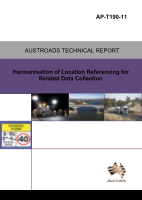Asset Management

- Publication no: AP-T190-11
- ISBN: 978-1-921991-07-3
- Published: 21 October 2011
- PDF (free) Download
This report presents and reviews common linear and spatial location referencing systems used by road authorities and discusses the various benefits and limitations of each. Road authorities have traditionally used linear location referencing to define and locate their assets. However each road authority typically has its own unique combination of location referencing methods and systems, evolved and tailored to cater for the unique characteristics of their respective road network and business needs. The variance between location referencing systems and a lack of detailed common ground limits data transfer between member authorities and aggregation of higher order comparative databases (i.e. at the national level). It also creates extra work in planning and conducting data collection surveys, in that new data collection systems must be developed for each new data collection exercise to suit each location referencing regime.
- 1. INTRODUCTION
- 1.1. General
- 1.2. Objectives
- 1.3. Location Referencing Background
- 1.3.1. Location Referencing Method
- 1.3.2. Location Referencing System
- 1.4. Harmonisation
- 1.5. Report Structure
- 2. PROJECT APPROACH
- 2.1. Project Workshop
- 3. LINEAR REFERENCING
- 3.1. Linear Referencing Approaches
- 3.1.1. Kilometre Post
- 3.1.2. Kilometre Point
- 3.1.3. Reference Post
- 3.1.4. Reference Point
- 3.1.5. Link/Node Approach
- 3.2. Current Member Authority Linear Referencing Systems
- 3.2.1. Main Roads Western Australia (MRWA)
- 3.2.2. Department of Infrastructure, Energy and Resources, Tasmania (DIER)
- 3.2.3. Department for Transport, Energy and Infrastructure, South Australia (DTEI)
- 3.2.4. Roads Corporation, Victoria (VicRoads)
- 3.2.5. Summary of Practices
- 3.3. Issues and Limitations
- Rubber banding
- 4. SPATIAL REFERENCING
- 4.1. Coordinate Systems
- 4.1.1. Geographic Coordinate Systems
- 4.1.2. Projected Coordinate Systems
- 4.2. Datum
- 4.2.1. Local Datum
- 4.2.2. Geocentric Datum
- 4.3. Projections
- 4.4. Positioning
- 4.4.1. Global Positioning System
- 4.4.2. Limitations and Accuracy of GPS
- 4.4.3. Data Accuracy Improvement Techniques
- 4.5. Application of Spatial Data
- 4.6. Current Member Authority Practices
- 4.6.1. Main Roads Western Australia (MRWA)
- 4.6.2. Department of Infrastructure, Energy and Resources, Tasmania (DIER)
- 4.6.3. Department for Transport, Energy and Infrastructure, South Australia (DTEI)
- 4.6.4. Roads Corporation, Victoria (VicRoads)
- 5. HARMONISED LOCATION REFERENCING
- 5.1. Characteristics of a Harmonised Approach
- 5.1.1. Guiding Principles
- 5.2. Linear Referencing Harmonisation Approach
- 5.3. Spatial Referencing Harmonisation Approach
- 5.3.1. Harmonised Spatial Road Location Referencing Method
- 5.3.2. Benefits
- 5.3.3. Constraints
- 5.3.4. Possible Method for Applying the Spatial Approach
- 6. CONCLUSIONS
- REFERENCES
- APPENDIX A MAIN ROADS WESTERN AUSTRALIA (MRWA) LINEAR REFERENCING SYSTEM
- APPENDIX B TASMANIA DEPARTMENT OF INFRASTRUCTURE, ENERGY AND RESOURCES (DIER) LINEAR REFERENCING SYSTEM
- APPENDIX C MAP PROJECTIONS
